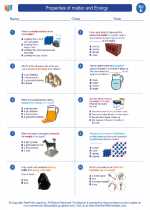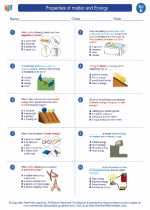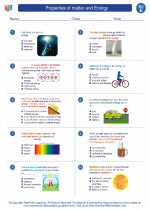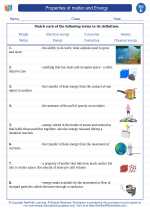Properties of matter and Energy -> electricity
What is Electricity?
Electricity is a form of energy resulting from the existence of charged particles (such as electrons or protons), either statically as an accumulation of charge or dynamically as a current.
Types of Electricity
There are two main types of electricity: static electricity and current electricity. Static electricity is the build-up of an electrical charge on the surface of an object, while current electricity is the flow of electric charge through a conductor.
How is Electricity Generated?
Electricity can be generated in various ways, including through the movement of a conductor within a magnetic field (as in a generator), chemical reactions (as in a battery), or through the conversion of solar energy (as in solar panels).
Components of an Electrical Circuit
An electrical circuit typically consists of a power source (such as a battery or generator), conductors (wires) to carry the electric current, and a load (such as a light bulb or motor) that uses the electrical energy. Additionally, switches and resistors may also be included in a circuit.
Basic Concepts in Electricity
It's important to understand basic concepts such as voltage, current, resistance, and power in electricity. Voltage is the force that pushes the electric charge through a conductor, while current is the flow of electric charge. Resistance is the opposition to the flow of current, and power is the rate at which electrical energy is transferred by an electric circuit.
Uses of Electricity
Electricity is used in various aspects of our daily lives, including lighting, heating, transportation, and powering electronic devices. Understanding the principles of electricity is crucial for advancements in technology and innovation.
Key Terms in Electricity
- Conductor: A material through which electric current can pass.
- Insulator: A material that does not allow electric current to pass through easily.
- Circuit: A closed loop through which an electric current can flow.
- Ohm's Law: The relationship between voltage, current, and resistance in an electrical circuit.
- Direct Current (DC): Electric current that flows in one direction.
- Alternating Current (AC): Electric current that changes direction periodically.
Studying these key terms and concepts will provide a solid foundation for understanding electricity and its applications in the world around us.
[Electricity] Related Worksheets and Study Guides:
.◂Science Worksheets and Study Guides Fifth Grade. Properties of matter and Energy

 Worksheet/Answer key
Worksheet/Answer key
 Worksheet/Answer key
Worksheet/Answer key
 Worksheet/Answer key
Worksheet/Answer key
 Vocabulary/Answer key
Vocabulary/Answer key
 Vocabulary/Answer key
Vocabulary/Answer key
